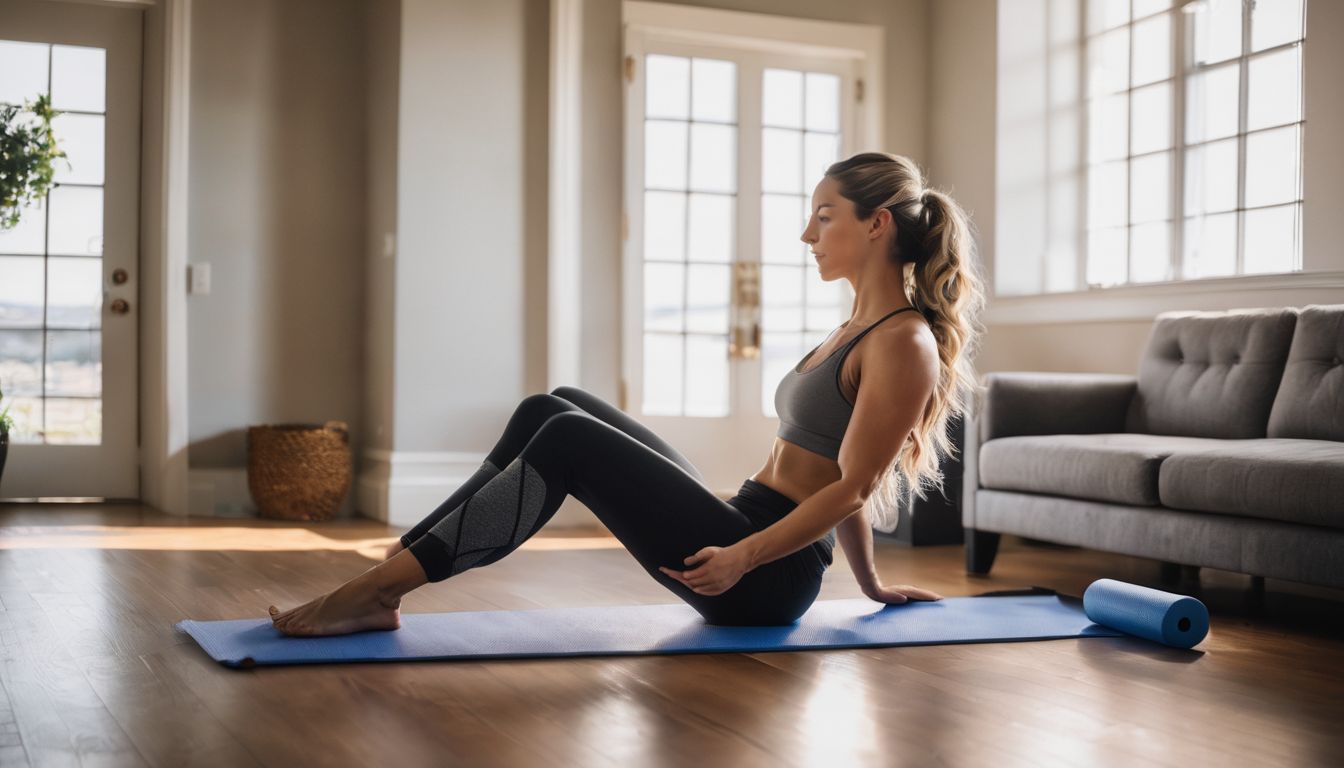
Feeling your back hurts after workout, with that ache in your back after pumping iron or hitting the gym can throw a wrench in your fitness routine. It’s not uncommon; lower back pain is often just your body telling you it needs a little extra care.
This article lays out five easy-to-follow tips to help soothe and prevent future discomfort. Read on and get back to feeling strong!
Key Takeaways
- Active stretching improves flexibility and reduces tension in muscles that support the lower back. Incorporate stretches for hamstrings, hip flexors, and glutes into your routine to maintain hip and pelvis range of motion.
- Use proper form during workouts like maintaining a neutral spine during squats and bending with hips rather than the waist to prevent excess strain on your back muscles.
- Strengthen core muscles through exercises such as planks or Russian twists to stabilize your spine; this helps enhance balance, posture, and overall workout performance while reducing injury risk.
- When experiencing lower back pain after exercise, apply ice followed by heat therapy, rest adequately, consider anti-inflammatory meds if necessary (after consulting with healthcare professionals), and perform gentle stretches/exercises for relief.
- If engaging in strength training like using Bowflex machines or free weights, focus on correct technique to build muscle without putting undue stress on the back; start with lighter loads before gradually increasing intensity.
Understanding How Your Back Hurts After A Workout
Experiencing lower back pain after a workout could be due to overdoing it, muscles being overworked, or even pinched nerves. It’s important to understand the reasons behind the pain in order to effectively address and prevent it in the future.
You May Have Overdone It
Pushing your limits during workouts is great, but sometimes the zeal to lift heavier weights or complete more reps can lead to back injury. If you feel sharp pain after deadlifts, squats, or other physical activities that target your core muscles, it’s possible you’ve gone too far.
Overtraining can cause muscle soreness beyond the typical delay-onset muscle soreness (DOMS) and may even result in a soft tissue injury that needs attention.
It’s important to listen to your body and recognize signs like weakness, numbness, tingling in your lower extremities which suggest you might need rest or possibly see a therapist.
Core strengthening is crucial for spine support; however, without proper form and balance between physical activity and recovery time, you risk harming those vital muscles. High-intensity interval training should push boundaries safely without causing chronic pains or conditions requiring physical therapy.
Your Muscles Have Been Overworked
Going beyond your limits during a workout can lead to your muscles being overworked, especially in the lower back. This often results from repetitive motions or lifting weights that are too heavy without proper form.
Overworked muscles tend to tighten up and may cause shooting pain or discomfort in your back, signs of what many refer to as delayed-onset muscle soreness (DOMS). It’s crucial to listen to your body and allow for adequate rest between strenuous exercises.
To prevent overworking the same muscle groups, it helps to integrate variety into your routine with activities like swimming or aerobic exercises that promote flexibility without excess strain on the back.
Strengthening exercises targeting the abdominal muscles, glutes, hamstrings, and quads can help support and alleviate pressure off the spine. Keeping these supporting muscles strong reduces the risk of exacerbating low back pain due to overexertion.
You May Have Pinched a Nerve
Sometimes, the cause of your back pain goes beyond muscle soreness and into nerve territory. Pinching a nerve can happen suddenly or over time, often when a herniated disc, arthritis, or spinal misalignment puts pressure on nerves in your back.
This pressure leads to sharp, shooting pains or a continuous prickly feeling that might travel from your lower back down to your feet.
Addressing a pinched nerve quickly is crucial for recovery and returning to your workouts without risking further injury. Consultation with a physical therapist can offer specific stretches and exercises tailored for relief, like the bird dog exercise aimed at strengthening both abdominal and gluteal muscles.
Remember that maintaining proper form during activities is vital; squatting incorrectly or hyperextending the spine increases the risk of such injuries. In cases where pain radiates beyond the lower back and into other areas such as buttocks or legs, it might signal sciatica—another reason to seek professional advice for effective pain management strategies.
5 Helpful Tips for When Your Back Hurts After a Workout

– Maintaining a neutral spine when squatting or bending over can help prevent lower back pain.
– Correctly performing squats and hip-hinging exercises can alleviate stress on your lower back muscles.
Maintaining a Neutral Spine When Squatting or Bending Over
To maintain a neutral spine when squatting or bending over, focus on keeping your back straight and not rounded. Engage your core muscles to support your lower back as you move. Keep your chest up and shoulders back to help align the spine properly during these movements.
Remember to avoid excessive arching of the lower back, which can lead to strain. Strengthening your core muscles will also help in maintaining a neutral spine during these exercises.
Squatting correctly involves keeping your knees behind your toes and pushing through your heels as you rise from the squat position. Bending (hip hinging) correctly entails initiating the movement from the hips while keeping a straight back throughout.
This technique helps distribute the load evenly across the body, protecting against unnecessary stress on the lower back.
Squatting Correctly
When performing squats, make sure to maintain proper form by keeping your feet shoulder-width apart and your chest up. Lower yourself as if you were sitting back into a chair, ensuring that your knees don’t extend beyond your toes.
Engage your core muscles and keep your back straight throughout the movement. It’s important to push through the heels as you stand back up, using the strength of your glutes and quadriceps.
To prevent injury while squatting, always start with a lighter weight or just use bodyweight until you’ve mastered the correct technique. Gradually increase the load as your strength improves.
Bending (Hip Hinging) Correctly
Engage your core muscles when you bend at the hips, keeping your back straight. Avoid rounding your lower back by pushing your hips backward as you lower down. This technique distributes the load evenly and reduces stress on your lower back.
Practice bending from the hip with a neutral spine to protect against potential injury during movements such as deadlifts, kettlebell swings, or picking up weights off the floor. Strengthening and maintaining proper hip hinging technique will help alleviate strain on the spine while promoting optimal muscle engagement and performance during workouts.
Strengthening Your Core Muscles
To strengthen your core muscles, engage in exercises like planks, Russian twists, and bicycle crunches. These movements target the abdominal muscles and the lower back, helping to stabilize and support your spine during workouts.
Incorporating these exercises into your routine can improve posture and overall strength.
Building a stronger core not only supports your back but also enhances athletic performance and reduces the risk of injury during physical activities. By focusing on strengthening your core muscles, you’ll experience improved stability and balance throughout various workout routines.
Stretch to Relieve and Prevent Your Back Hurts After A Workout
Stretching regularly can help alleviate and prevent low back pain. Incorporating gentle stretches into your daily routine can improve flexibility and ease tension in the muscles supporting your lower back.
Focus on stretches that target the hamstrings, hip flexors, and glutes to maintain optimal range of motion in the hips and pelvis. By including these stretches in your warm-up or cooldown routine, you actively contribute to reducing the risk of muscle soreness and discomfort after workouts.
Consistent stretching also helps promote blood circulation to the area, assisting in muscle recovery while decreasing any potential stiffness or tightness that may lead to discomfort.
Bowflex Back Exercises for Strength and Flexibility
- Lat Pulldown: Sit with your knees under the pad, grip the bar wider than shoulder-width, and pull it down to your chest, engaging your back muscles.
- Seated Rows: Sit and pull the handles towards you, squeezing your shoulder blades together to strengthen your upper back.
- Reverse Fly: Stand with bands or cables at chest height, pull them apart with straight arms, and bring them back in a controlled manner to target your upper back muscles.
- Superman Extensions: Lie on your stomach, raise your arms and legs simultaneously while contracting your lower back muscles.
- Deadlifts: With proper form using a neutral spine, lift weights from the ground to engage various muscles in your core and lower back without overloading your spine.
How to Treat Lower Back Pain If Your Back Hurts After a Workout
Apply ice to the affected area for 15-20 minutes every few hours during the first 48 hours, then switch to heat. Rest and avoid activities that exacerbate the pain. Consider over-the-counter anti-inflammatory medication if needed, but consult a healthcare professional before taking any new medication.
Stretching and gentle exercises can help relieve muscle tension and promote healing.
Maintain good posture throughout your day. Use proper lifting techniques and avoid heavy lifting or bending at the waist after a workout. A supportive mattress and sleeping position are crucial for relieving back pain while you sleep.
If symptoms persist or worsen, seek medical attention promptly to address any underlying issues causing your lower back discomfort.
Conclusion
In conclusion, it’s crucial to maintain a neutral spine when performing exercises. Strengthening your core muscles is essential for preventing and relieving low back pain. Ensure proper form when squatting and bending over to avoid straining your lower back.
Stretching regularly can help alleviate muscle soreness and prevent future discomfort. Remember that understanding the causes of lower back pain post-workout is the first step toward effective treatment and prevention.
FAQs
1. Why does my lower back hurts after a workout?
Your lower back might be hurting due to overuse injuries from exercises like back squats, poor form leading to muscle soreness, or even a herniated disc caused by hyperextension during workouts.
2. Can warming up prevent back pain after working out?
Yes! Warming up before exercising helps prepare your muscles and can reduce the chances of acute back pain by avoiding strains that occur when muscles are tight.
3. How can physiotherapy help if I have chronic lower back pain from workouts?
A physiotherapist can teach you methods like the McKenzie method to manage and relieve your neck and radiating pain. They may also guide you through specific exercises that strengthen your transverse abdominals and abdomen area for better support.
4. Should I wear compression stockings if my veins hurt after leg workouts?
Compression stockings are designed to support veins, reduce soreness in legs, and could assist with recovery if you experience vein-related discomfort following intense leg-focused activities such as barbell squats.
5. Are massages good for relieving muscle soreness if my back hurts after a workout?
Sports massage therapy is a great way to provide relief for muscles soreness by massaging the affected areas which improves blood flow and aids in quicker recovery.
6. What should I do immediately if I feel sharp acute pain in my back during an exercise?
If you feel sudden acute pain while working out, stop immediately to prevent further injury like dislocations or fractures stemming from conditions like osteoporosis; seek urgent attention either from heart specialists or therapists depending on the type of pain experienced.



